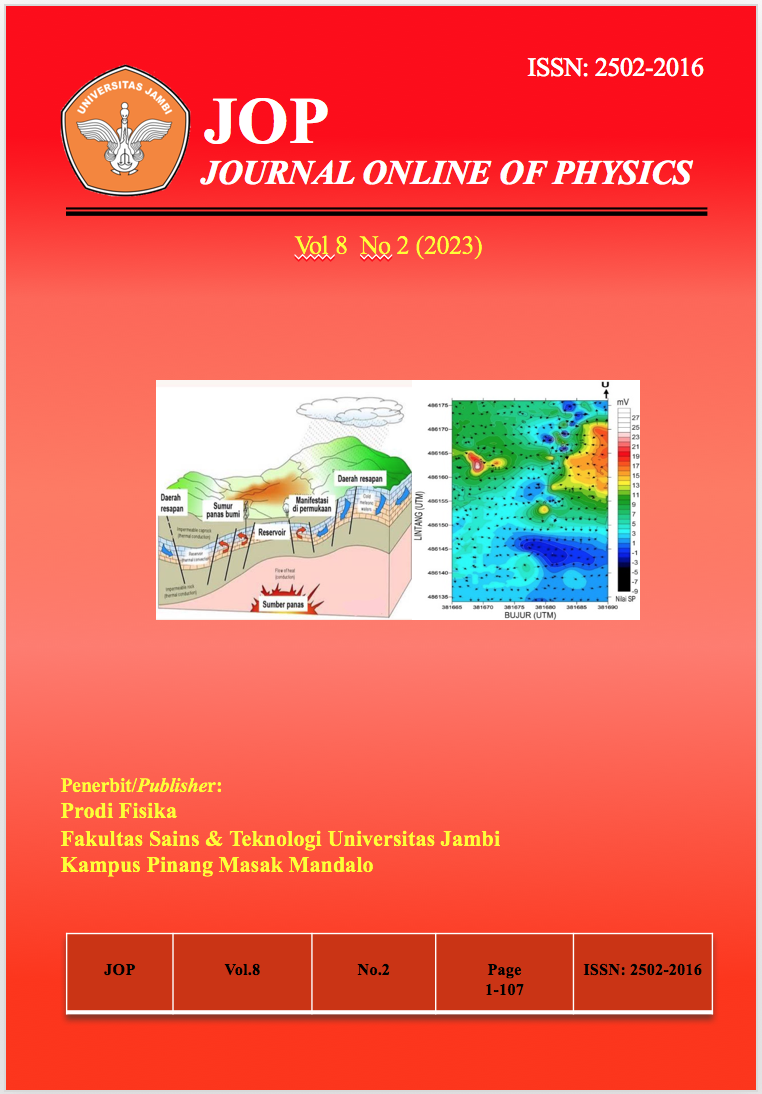ANALYSIS OF ACTIVATED CARBON (PETUNG BAMBOO)/LATEX COMPOSITE AS X-BAND WAVE-ABSORBING MATERIAL
DOI:
https://doi.org/10.22437/jop.v8i2.23851Keywords:
Activated carbon, latex, petung bamboo, reflection lossAbstract
In maintaining the sovereignty of a country, especially in border regions was needed defense tools that had the latest technology, such as stealth technology. Stealth technology was applied to military ships or aircraft so that they could not be detected by Radio Detection and Ranging. Stealth technology in this research was realized by coating the ship's or aircraft's body using RAM (Radar Absorbing Material). RAM could be composed of dielectric materials, such as activated carbon. The activated carbon was synthesized from Dendrocalamus Asper. This research aimed to analyze the proper of composition the composite and thickness of the RAM for the X-band wave range. The methods were carbonization, activation by KOH and HCl solutions, and characterization. The characterizations were by XRD, FTIR, and SEM to identify the active carbon phase, and VNA to determine the value of reflection loss. The variations in this research were composite composition (7:3, 9:1) and thickness (1mm, 3mm). And obtained that it has been formed a composite of activated carbon of petung bamboo and latex of rubber tree, which is indicated by the formation of two broad peaks in the diffraction pattern, the presence of band groups C=C, C-C, C-H, C-O, O-H, and morphology with a porous structure. In addition, the highest reflection loss is obtained for the 9:1 composite and thickness of 3 mm, which reached -17.25 dB at a frequency of 9.32 GHz.
Downloads
References
Adnyana, K.R.T. 2022. State Sovereignty in International Law. Journal of Pacta Sunt Servanda. 3(2), 32-41.
Agarwal, M., et al. 2017. Facile Synthesis of KCl: Sm3+ Nanophosphor as a New OSL Dosimetric Material Achieved Through Charge Transfer Between The Defect States. RSC advances. 7(23), pp.13836-13845.
Azmi, et al. 2011. National Archival Media Archives - Home of the State in the Frame of the Republic of Indonesia. Issue 56. Jakarta: National Archives of the Republic of Indonesia.
Cullity, B.D. and S.R. Stock. 2014. Elements of X-ray Diffraction: Third Edition. Pearson Education Limited. ISBN: 978-1-292-04054-7.
Durmus, Z., Durmus, A. and Kavas, H. 2015. Synthesis and Characterization of Structural and Magnetic Properties of Graphene/hard Ferrite Nanocomposites as Microwave-absorbing Material. Journal of Materials Science, 50(3), pp.1201-1213.
Gaylor, K. 1989. Radar Absorbing Materials-Mechanisms and Materials. Australia: DSTO Materials Research Laboratory.
Ghasemi A, Hossienpour A, and Morisako A. 2008. Investigation of The Microwave Absorptive Behavior of Doped Barium Ferrites. Material Design. 29: 112-117.
Hoesada, J. 2007. Impact of Radar Innovation on Defense and Security. Jakarta: SATRIA Defense Studies. Vol. 3, No. 1.
Kurniawan, A.F., Anwar, M.S. and Nadiyyah, K. 2019. Mechanical Exfoliation of Reduced Graphene Oxide from Old Coconut Shell as Radar Absorber In X-Band. In Materials Science Forum. Vol. 966, pp. 25-29. Trans Tech Publications Ltd.
Liu, X.Y., et al. 2010. Preparation of a Carbon-Based Solid Acid Catalyst by Sulfonating Activated Carbon in a Chemical Reduction Process. Molecules. 15(10), pp.7188-7196.
Mashuri, et al. 2020. Synthesis and Microwave Absorption Properties of Natural Graphene (reduced graphene oxide) Based on Yellow Bamboo Charcoal (Bambusa Vulgaris), Ori (Bambusa Bambos Miq), and Petung (Dendrocalamus Asper). Journal of Physics and Its Applications. 16(3), pp.173-178.
Mecozzi, M., et al. 2012. Monitoring of Marine Mucilage Formation in Italian Seas Investigated by Infrared Spectroscopy and Independent Component Analysis. Environmental Monitoring and Assessment. 184(10), pp.6025-6036.
Mentari, V.A., Handika, G. and Maulina, S. 2018. Comparison of Function Groups and Surface Morphology of Activated Carbon from Palm Fronds Using Phosphoric Acid (H3PO4) and Nitric Acid (HNO3) Activators. USU Journal of Chemical Engineering. 7(1), pp.16-20.
Mistar, E.M., Alfatah, T. and Supardan, M.D. 2020. Synthesis and Characterization of Activated Carbon from Bambusa Vulgaris Striata Using Two-Step KOH Activation. Journal of Materials Research and Technology. 9(3), pp.6278-6286.
Mitrayana. 2015. Microwave Theory and Applications. Yogyakarta: Gajah Mada University.
Mojoudi, N., et al. 2019. Phenol Adsorption on High Microporous Activated Carbons Prepared from Oily Sludge: Equilibrium, Kinetic, and Thermodynamic Studies. Scientific Reports. 9(1), pp.1-12.
Pattanaik, B., and Chauhan, A. 2012. A research of stealth technology. Materials Today: Proceedings.
Saville, P. 2005. Review of Radar Absorbing Materials. Canada: Defence Research and Development Atlantic Dartmouth.
Shkal, F., Lopez, S.G., Slocombe, D. and Porch, A. 2017. Microwave Characterization of Activated Carbons. Journal of Computer and Communications. 6(1), pp.112-123.
Triwiyoso and Siswantoro. 1995. In House Trainning Processing of Concentrated Latex and Raw Rubber. Bogor: Plantation Research Center.
Yohandri, Debi, R. and Ananda P. 2017. Research of single film Radar Absorber Material (RAM) Based on Coconut Shell Activated Carbon. 2017 Progress In Electromagnetics Research Symposium-Fall (PIERS-FALL). Pp. 1536-1539. doi: 10.1109/PIERS-FALL.2017.8293376.
Zhang, K., et al. 2018. Effect of Absorbers' Composition on The Microwave Absorbing Performance of Hollow Fe3O4 Nanoparticles Decorated CNTs/graphene/C Composites. Journal of Alloys and Compounds. 748, pp.706-716.











